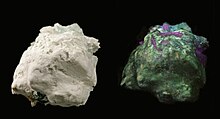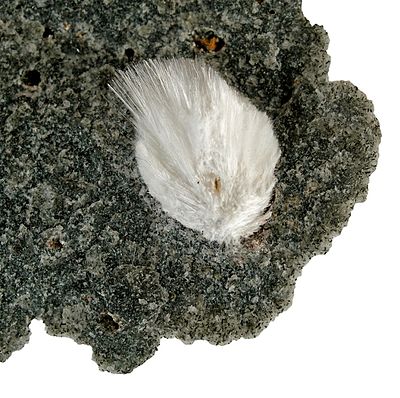Macatite
| Macatite | |
|---|---|
| Tufts of needle-like macatite from the quarries near Aris in the Khomashochland , Namibia ( overall size : 7.5 cm × 3.9 cm × 1.7 cm) | |
| General and classification | |
| other names |
|
| chemical formula | Na 2 [Si 4 O 8 (OH) 2 ] • 4H 2 O |
|
Mineral class (and possibly department) |
Silicates and germanates - layered silicates |
|
System no. to Strunz and to Dana |
9.EE.45 ( 8th edition : VIII / G.05) 74.03.05.02 |
| Similar minerals | Mesolite , natrolite , scolezite |
| Crystallographic Data | |
| Crystal system | monoclinic |
| Crystal class ; symbol | monoclinic prismatic; 2 / m |
| Room group (no.) | P 2 1 / c (No. 14) |
| Lattice parameters |
a = 7.39 Å ; b = 18.09 Å; c = 9.52 Å β = 90.6 ° |
| Formula units | Z = 4 |
| Physical Properties | |
| Mohs hardness | soft |
| Density (g / cm 3 ) | measured: 1.97 to 2.07; calculated: [2.05] |
| Cleavage | clearly to completely parallel to the longitudinal axis, {010} |
| colour | colorless, white |
| Line color | White |
| transparency | transparent to translucent |
| shine | Glass gloss, silk gloss, matt |
| Crystal optics | |
| Refractive indices |
n α = 1.472 to 1.475 n β = 1.480 n γ = 1.487 to 1.490 |
| Birefringence | δ = 0.015 |
| Optical character | biaxial positive |
| Axis angle | 2V = 70 ° (measured) |
Makatite is a very rarely occurring mineral from the mineral class of "silicates and germanates". It crystallizes in the monoclinic crystal system with the chemical composition Na 2 [Si 4 O 8 (OH) 2 ] · 4H 2 O and thus is chemically seen a hydrous sodium - silicate . Structurally it belongs to the layered silicates .
Makatite develops needle-like to prismatic, striped crystals up to about one centimeter in length with a glass-like sheen on the surfaces, which are usually connected to fibrous or radial to spherulitic mineral aggregates . In its pure form, macatite is colorless and transparent. However, due to the multiple refraction of light due to the predominantly polycrystalline forms , it generally appears translucent white and has a more silk-like gloss or is matt. Very rarely does it take on a pale, bluish-white or greenish-white color as a result of foreign admixtures.
Special properties

Under UV light , some Makatites show a greenish-white fluorescence , similar to that of neon-colored highlighters . Makatite can thus be differentiated from pectolite , which looks quite similar but fluoresces red to blue-violet .
There is also a risk of confusion due to their similar color and crystal shape with mesolite and natrolite , which however crystallize orthorhombically and have no fluorescence, and with scolecite , which fluoresces yellow to brown.
Etymology and history
Makatit was named based on its sodium content after the Masai word "emakat" ( mä'kătit ), which means soda or baking soda.
The mineral was first discovered in 1968 by Richard L. Hay in rock samples taken from a drill core on Lake Magadi from a depth of 94 ft (approx. 28.65 m). Lake Magadi is a lake of soda and is located in the eastern arm of the East African Rift in Kenya . Makatite was scientifically described and named in 1970 by Richard A. Sheppard, Arthur J. Gude and Richard L. Hay.
The type material of the mineral is kept in the National Museum of Natural History in Washington, DC, USA (Catalog No. 122170, 122171).
classification
In the outdated, but partly still in use, 8th edition of the mineral classification according to Strunz , the makatite belonged to the mineral class of "silicates and germanates" and there to the department of "transition structures between chain and layered silicates", where together with searlesite and silinaite it belongs to the unnamed group VIII / G.05 .
The 9th edition of Strunz's mineral systematics , which has been in effect since 2001 and is used by the International Mineralogical Association (IMA), assigns makatite to the class of “silicates and germanates”, but there it is in the “phyllosilicates” section . This is also further subdivided according to the layer structure, so that the mineral, according to its structure, can be found in the sub-section "Simple tetrahedral networks of 6-membered rings, connected by octahedral networks or bands", where it is the only member of the unnamed group 9. EE.45 forms.
The systematics of minerals according to Dana , which is mainly used in the English-speaking world , assigns the to the class of "silicates and Germanates" and there in the department of "layered silicates: modulated layers". Here it is together with natrosilite , searlesite and silinaite in the " sodium layered silicate " with the system no. 74.03.05 can be found in the sub-section “ Layered Silicates: Modulated Layers with Connected Stripes”.
Education and Locations

Makatit formed by chemical sedimentation in evaporites where it depending on the location in Paragenesis among others Aegirin , anorthoclase , erionite , Eudialyt , Gaylussite , Lovozerit , magadiite , natrolite , Shkatulkalit , sodalite , Steenstrupin , Trona , ussingite , Varennesit , Vuonnemit , Zakharovit occurs.
As a very rare mineral formation, Makatite was only known in a few samples from less than 10 localities. Its type locality Lake Magadi, where the minerals kenyaite and magadiite were first discovered (H. P. Eugster, 1967), is the only site in Kenya to date.
Other previously known sites are the Poudrette quarries on Mont Saint-Hilaire and Demix- Varennes near Saint-Amable (municipality of Marguerite-D'Youville , formerly Lajemmerais ) in the Canadian province of Québec, the Höwenegg quarry near Immendingen in the German state of Baden-Württemberg those at Aris quarries in the Khomashochland of Namibia as well as the Kukiswumtschorr in the Chibinen and the Alluaiw in the Lowosero Tundra massif on the Russian Kola peninsula .
Crystal structure
Makatite crystallizes monoclinically in the space group P 2 1 / c (space group no. 14) with the lattice parameters a = 7.39 Å ; b = 18.09 Å; c = 9.52 Å and β = 90.6 ° as well as four formula units per unit cell .
See also
literature
- Richard A. Sheppard, Arthur J. Gude, Richard L. Hay: Makatite, a new hydrous sodium silicate mineral from Lake Magadi, Kenya. In: American Mineralogist. Volume 55 (1970), pp. 358-366 ( PDF 537.7 kB )
- H. Annehed, L. Fälth, FJ Lincoln: Crystal structure of synthetic makatite Na 2 Si 4 O 8 (OH) 2 · 4H 2 O. In: Zeitschrift für Kristallographie. Volume 159 (1982), pp. 203-210 ( PDF 694.3 kB ; from p. 11)
- NV Zubkova, IV Pekov, DY Pushcharovsky: A review of crystal chemistry of natural silicates of alkaline elements in the light of new structural data. In: Mineralogical Magazine. Volume 78 (2014), pp. 253-265
Web links
- Mineral Atlas: Makatite (Wiki)
- Database-of-Raman-spectroscopy - Makatite
- American-Mineralogist-Crystal-Structure-Database - Makatite
Individual evidence
- ↑ a b c d e Hugo Strunz , Ernest H. Nickel: Strunz Mineralogical Tables . 9th edition. E. Schweizerbart'sche Verlagbuchhandlung (Nägele and Obermiller), Stuttgart 2001, ISBN 3-510-65188-X , p. 683 .
- ↑ a b c d Makatite , In: John W. Anthony, Richard A. Bideaux, Kenneth W. Bladh, Monte C. Nichols (Eds.): Handbook of Mineralogy, Mineralogical Society of America , 2001 ( PDF 72.5 kB )
- ↑ Webmineral - Makatite
- ↑ a b c Mindat - Makatite
- ↑ Mindat - picture example of colorless and transparent macatite crystals
- ^ A b Richard A. Sheppard, Arthur J. Gude, Richard L. Hay: Makatite, a new hydrous sodium silicate mineral from Lake Magadi, Kenya. In: American Mineralogist. Volume 55 (1970), pp. 358-366 ( PDF 537.7 kB )
- ↑ Mindat - type locality Lake Magadi, South Rift Valley, Rift Valley Province, Kenya
- ↑ List of localities for Makatite in the Mineralienatlas and Mindat

